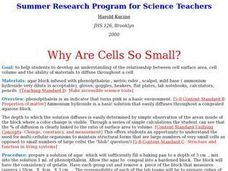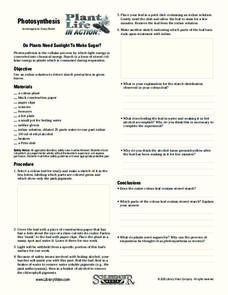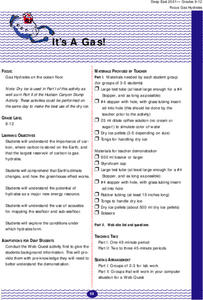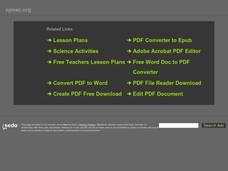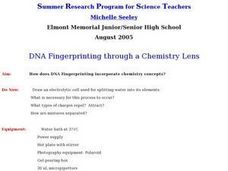Curated OER
Acid Rain Simulation
Young scholars collect data on causes of Acid Rain. In this science lesson, students simulate the effects that produce acid rain, collect and analyze data from their samples. They relate science and statistics in this lesson.
Curated OER
Why Are Cells So Small?
Students examine the relationship between cell surface area and the ability of materials to diffuse through a cell. They participate in an experiment in which they determine which materials diffuse easier than others. They complete...
Curated OER
Simulating the Spread of an Infectious Disease
In this health worksheet, students identify various infectious diseases and explore the available options for stopping or preventing the spread of disease. They participate in a simulation experiment on how to measure and prevent. There...
Curated OER
Acid Rain And Geology
Students become aware of the environmental problems caused by acid rain and study the pH scale. They determine acidity of local rain water.
Curated OER
The Hijacker - How a Virus Spreads
Students view a video that presents how viruses attack the body and how the body's immune system responds. They simulate the spread of an infectious disease and establish the identity of the original carrier.
Curated OER
The Floating Golf Ball
Students explore density by floating golf balls. They explore having their golf balls float halfway in a container of water and discuss density and its realtionship to where the golf balls are floating. After adding food coloring, they...
Curated OER
Chemical Reactions
In this chemical reactions activity, learners calculate the molar mass and the rate of reaction for the given chemical reactions. This activity has 3 problems to solve.
Curated OER
Chemical Equations
In this chemical equations worksheet, students are given the trends for the reactions between the alkaline earth metals with water, the solubility of the Group II hydroxides and the solubility of the Group II sulphates.
Curated OER
Photosynthesis
In this photosynthesis worksheet, middle schoolers follow the steps to complete a science investigation and then respond to 8 short answer questions regarding the photosynthesis investigation.
Curated OER
Teaching Avogadro's Number
Students design an experiment to determine Avogadro's number. Students utilize an ammeter, an electrolytic cell and internet research.
Curated OER
Activity #5 Environmental Effects
Students explain the implications of particle theory of The Law of Conservation of Matter for problems of pollution and waste disposal. They describe, in terms of atoms and molecules, what happens to materials when they are dissolved or...
Curated OER
What's the Difference Between Concentration and Solubility?
Students discuss the difference between concentration and solubility as well as examine the difference in a hands-on activity. Using water and table salt, they experiment with solubility. They create different concentrations using water...
Curated OER
Chemistry: Metals and Non-Metals
Learners conduct an experiment to test the reactivity of metals and non-metals. In this chemistry lesson students test metals with different chemicals to observe the reaction. The results are used to categorize the metals.
Curated OER
Off Base
Students study La Chatelier's principle and identify how carbon dioxide may affect pH. For this coral lesson students complete a worksheet on pH and observe a lab.
Curated OER
It's a Gas!
Pupils explore the conditions under which hydrates form. They use the Internet to access information and conduct experiments to examine how the greenhouse effect works.
Curated OER
The Tongue...A Sense of Taste
Students explore the sense of taste. In this biology lesson plan, students consider 4 types of tastes, recognize the papillae or receptors on the tongue, and locate and label the different taste sense organs on the tongue.
Curated OER
Solubility and Chemical Changes in Groundwater
Students test pH of water before and after it travels through different substrates (igneous pebbles and limestone) to detemine how soluble materials can affect groundwater. They answer questions such as: What happended to the pH of the...
Curated OER
Spectrophotometric Determination of an Equilibrium Constant
High schoolers determine the equilibrium constant for a chemical system and use graphing techniques and data analysis to evaluate experimental data.
Curated OER
Let it Grow and See What Happens
Students participate in an experiment in which they try to stop algae from growing. In groups, they develop a hypothesis and test it while making changes to the experiment along the way. They make observations and organize their data...
Curated OER
Water Quality Monitoring
Students study the water quality of a stream in their area, by measuring the temperature, pH, alkalinity and conductivity. They integrate biology with earth science when using the microscope to study the living organisms in the water.
Curated OER
pH Potential
Students experiment to determine the positive and negative impacts of human activities on environmental change. They examine how physical and biological processes such as decomposition affect soil characteristics while looking at the pH...
Curated OER
DNA Fingerprinting through a Chemistry Lens
Students explore DNA and restriction enzymes using fragments of DNA separated by electrophoresis on an agarose gel. They analyze the results to see "whodunit".
Curated OER
Selecting Soil Organisms in Compost
Learners conduct an experiment to demonstrate that many of the enzyme systems needed to break down society's wastes exist in nature among the decomposers in a compost pile. They culture compost bacteria on starch agar to examine the...
Curated OER
Selecting Soil Organisms in Compost
Students demonstrate that many of the enzyme systems needed to break down--and therefore clean up-society's wastes already exist in nature among the decomposers. They select the best starch-munching organisms by altering the environment...



